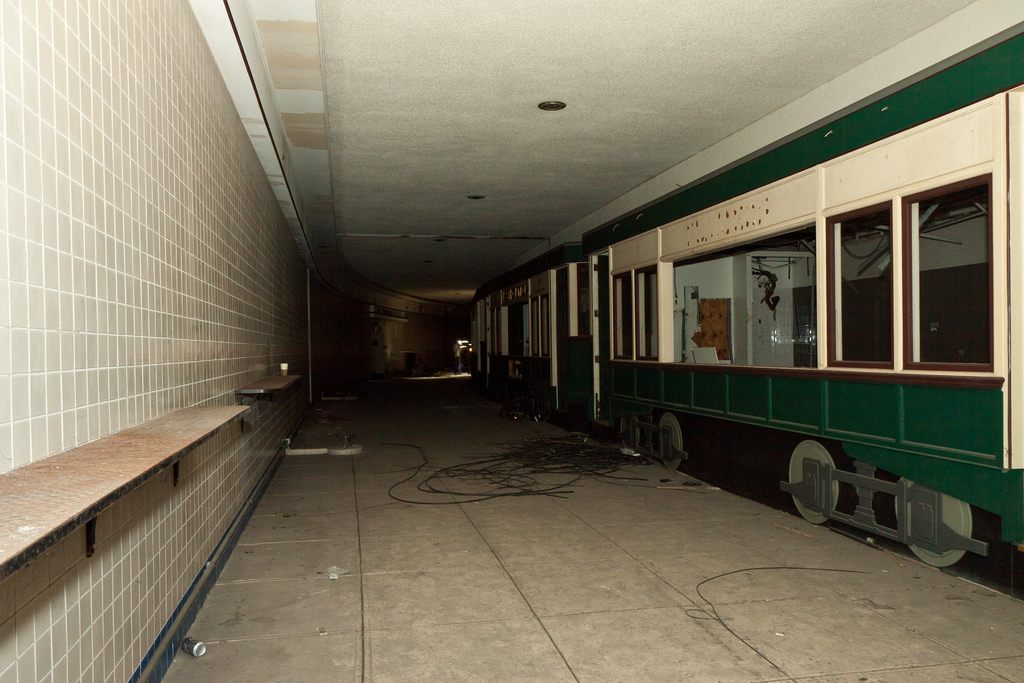One of D.C.’s Most Contentious Pieces of Real Estate is 25 Feet Underground

The Dupont Underground’s east platform, which the organization will be opening first. (Photo: Dupont Underground/Pat Padua)
In the upscale Washington, D.C. neighborhood of Dupont Circle, where galleries, bars, and bookshops jostle for room, a 75,000-square-foot expanse in the heart of the quarter has been almost untouched for 20 years. That’s because in order to access it, you have to grab a flashlight and descend 25 feet below ground, into the vast, abandoned streetcar tunnels that flank Connecticut Avenue.
For the past 60 years, the city and its residents have wondered what to do with this vast subterranean space, whose history features a long list of failed attempts to repurpose it, including plans to make it into a gym, a greenmarket, and a storage facility for funeral urns.

Inside the Dupont tunnels. (Photo: Preston Rhea/flickr)
Today, the tunnels look much the same as they did in their mid-century heyday; the tracks and tiling are still intact, and the closed off stairwells to the aboveground streets have melted into the background of the neighborhood, filling with trash and largely ignored. In late 2014, after a decade of campaigning the city, an arts coalition called the Dupont Underground signed a five-year lease on the space for $30,000 a year, with plans to transform the barren tunnels into a cultural hub that could host concerts, art installations, and other programming.
“Nobody wanted the space,” says Braulio Agnese, the Managing Director of Dupont Underground. “It had largely been forgotten. It’s a very unusual development on a number of fronts, and there’s absolutely no precedent for something like this in DC.”
But transforming a neglected tunnel network into a place where visitors could be allowed to enter comes with huge challenges. In order to bring the space up to code, ventilation, sewage, and electricity systems need to be installed or expanded. And unlike an aboveground space, there’s not much room for altering the fundamental structure of the station. “It’s a concrete box,” says Agnese. “There are just inherent difficulties: The entrances are where they are, and you’ve got to work with that. But we understand some of the ways to make things happen.”
It isn’t the first attempt to repurpose the area below Dupont Circle. The twin tunnels were debuted in the late 1940s to relieve traffic on the busy Connecticut Avenue commuter trolley line. By the time the Dupont tunnels opened, streetcars, threatened by the rising popularity of cars, were already in decline. The station was only in operation for a little more than a decade until streetcar service, replaced by buses, ended in January 1962.

The former Dupont Down Under food court in 2011. The establishments were shaped like train cars. (Photo: ep_jhu/flickr)
In the late ‘60s, the tunnels were briefly used as a fallout shelter, but vandals broke in and stole the emergency supplies. In 1975, architect Arthur Cotton Moore, who had designed the Canal Square mall in Georgetown, won approval from the city to transform the tunnels into an underground shopping mall, but the project collapsed when he was unable to finance the project.
The city opened up the space for developers’ proposals again in 1982. But no new development took place in the tunnels until the early ‘90s, when Mayor Marion Barry approved the creation of Dupont Down Under, a mall-style food court to be built on the western platform of the Dupont tunnels. A line of fast food dinners—operating, naturally, out of streetcar-themed booths—would serve up pizza and subs to the public, flanked by a Laundromat, a newsstand, and a grocery store.

The south endpoint of the Dupont Underground. (Photo: Dupont Underground/Pat Padua)
The project opened in March 1995, and was initially celebrated by Washingtonians. In the Washington Post, architecture critic Benjamin Forgey hailed the projects as “a delightful occurrence, way overdue…it repairs a civic eyesore—or rather, a number of them—and adds a touch of much needed commercial vitality” to the area.
But as Forgey also noted, the food court, from the beginning, was plagued with problems. When it opened, only seven of the proposed 16 vendors had settled in. The design of the platform meant that the businesses closest to the entrance got all the food traffic, leaving the ones farther away without many customers. The space had no working elevators and no way for, say, a truck to get in, which meant that supplies and trash had to be carried in and out by hand. Plus, the tunnels, with their dank atmosphere, were more of a novelty than an attractive dining atmosphere.
On top of that, the developer, Geary S. Simon, came into the project with legal baggage. He had been convicted of several felonies, including mail fraud, in the 1980s, and had served time in jail. (A Washington Post headline about the project read “City Residents Unconcerned By Developer’s Criminal Past,” probably not the right note to start on.)

A photo illustration of the scope of the Dupont Underground space. (Photo: Dupont Underground/Hunt Laudi Studio)
By May 1996, just over a year after Dupont Down Under opened, the food court had fallen behind on its rent payments to the city. Seven of the original tenants joined to sue Simon for breach of contract, claiming that he had failed to develop the site as originally guaranteed. Several contractors and suppliers also sued Simon for payment they were owed. Only three fast food stalls and a booth that offered back rubs remained. Finally, in September, the city terminated its lease with Geary.
At the end, just one tenant remained—a Pizza Express, which had been shut down by the fire marshal for stealing electricity from a nearby meter. Dupont Down Under’s power was officially turned off by the following month. The stairwells were again locked to the public.
When Dupont Underground first leased the space, nearly two decades after the food court retreated, you could still find plastic trays stamped with the “Dupont Down Under” logo scattered on the floor of the abandoned stalls.

A rendering of the projected use of the space, with live music, dance, and experimental theater performances. (Photo: Dupont Underground/Hunt Laudi Studio)
Although reminded at almost every turn by the space’s design challenges and history of failed reinventions, the arts coalition is hoping to gradually revitalize the giant underground space, starting with the platform where the food court once stood. They plan to open up the tunnels piecemeal, in order to bring people in as soon as possible, and raise funds to slowly bring the rest of the tunnels up to code. In time, Dupont Underground envisions all kinds of events in the space—music recordings, experimental theater, pop-up restaurants, using the space for film and television.
Currently, the tunnels hold 750,000 plastic balls, part of a summer art installation that turned the National Building Museum into a giant ball pit. Agnese is using the balls as part of a design competition; the winning artist will use them in a site-specific installation to open in the Dupont Underground space this May. In the future, below Dupont Circle, there may be whiskey tastings, gallery openings, and film screenings. But a food court? Probably not.
Update, 1/12: An earlier version of this story noted that the food court was on the eastern platform. It was on the western side. We regret the error.
Gastro Obscura covers the world’s most wondrous food and drink.
Sign up for our email, delivered twice a week.

























Follow us on Twitter to get the latest on the world's hidden wonders.
Like us on Facebook to get the latest on the world's hidden wonders.
Follow us on Twitter Like us on Facebook